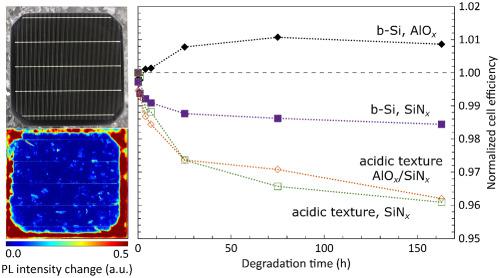当前位置:
X-MOL 学术
›
Prog. Photovoltaics
›
论文详情
Our official English website, www.x-mol.net, welcomes your
feedback! (Note: you will need to create a separate account there.)
Impact of black silicon on light‐ and elevated temperature‐induced degradation in industrial passivated emitter and rear cells
Progress in Photovoltaics ( IF 8.0 ) Pub Date : 2018-12-04 , DOI: 10.1002/pip.3088 Toni P. Pasanen 1 , Chiara Modanese 1 , Ville Vähänissi 1 , Hannu S. Laine 1 , Franziska Wolny 2 , Alexander Oehlke 2 , Christian Kusterer 2 , Ismo T.S. Heikkinen 1, 3 , Matthias Wagner 2 , Hele Savin 1
Progress in Photovoltaics ( IF 8.0 ) Pub Date : 2018-12-04 , DOI: 10.1002/pip.3088 Toni P. Pasanen 1 , Chiara Modanese 1 , Ville Vähänissi 1 , Hannu S. Laine 1 , Franziska Wolny 2 , Alexander Oehlke 2 , Christian Kusterer 2 , Ismo T.S. Heikkinen 1, 3 , Matthias Wagner 2 , Hele Savin 1
Affiliation

|
Light and elevated‐temperature induced degradation (LeTID) is currently a severe issue in passivated emitter and rear cells (PERC). In this work, we study the impact of surface texture, especially a black silicon (b‐Si) nanostructure, on LeTID in industrial p‐type mc‐Si PERC. Our results show that during standard LeTID conditions the b‐Si cells with atomic‐layer‐deposited aluminum oxide (AlOx) front surface passivation show no degradation despite the presence of a hydrogen‐rich AlOx/SiNx passivation stack on the rear. Furthermore, b‐Si solar cells passivated with silicon nitride (SiNx) on the front lose only 1.5%rel of their initial power conversion efficiency, while the acidic‐textured equivalents degrade by nearly 4%rel under the same conditions. Correspondingly, clear degradation is visible in the internal quantum efficiency (IQE) of the acidic‐textured cells, especially in the ~850 to 1100‐nm wavelength range confirming that the degradation occurs in the bulk, while the IQE remains nearly unaffected in the b‐Si cells. The observations are supported by spatially resolved photoluminescence (PL) maps, which show a clear contrast in the degradation behavior of b‐Si and acidic‐textured cells, especially in the case of SiNx front surface passivation. The PL maps also suggest that the magnitude of LeTID scales with surface area of the texture, rather than wafer thickness that was recently reported, although the b‐Si cells are slightly thinner (140 vs 165 μm). The results indicate that b‐Si has a positive impact on LeTID, and hence, benefits provided by b‐Si are not limited only to the excellent optical properties, as commonly understood.
中文翻译:

黑硅对光钝化和高温诱导的工业钝化发射极和后电池退化的影响
在钝化的发射极和后电池(PERC)中,光和高温引起的降解(LeTID)当前是一个严重的问题。在这项工作中,我们研究了表面纹理,特别是黑硅(b-Si)纳米结构对工业p型mc-Si PERC中LeTID的影响。我们的结果表明,在标准的LeTID条件下,尽管在背面存在富氢的AlO x / SiN x钝化叠层,但具有原子层沉积的氧化铝(AlO x)前表面钝化的b-Si电池没有降解。此外,正面钝化有氮化硅(SiN x)的b-Si太阳能电池的rel损失仅为1.5%在相同条件下,酸性结构的等效功率相对于初始功率转换效率下降了近4%rel。相应地,在酸性结构化电池的内部量子效率(IQE)中可见明显的降解,尤其是在约850至1100 nm波长范围内,这表明降解发生在主体中,而IQE在b中几乎不受影响。硅电池 这些观察结果得到空间分辨的光致发光(PL)图的支持,该图显示了b-Si和酸性结构化电池的降解行为的明显对比,特别是在SiN x的情况下前表面钝化。PL图还表明,尽管b-Si电池稍薄(140 vs 165μm),但LeTID的大小与纹理的表面积成比例,而不是与最近报道的晶片厚度成比例。结果表明,b-Si对LeTID有积极影响,因此,b-Si提供的好处不仅限于出色的光学性能,如通常所知。
更新日期:2018-12-04
中文翻译:

黑硅对光钝化和高温诱导的工业钝化发射极和后电池退化的影响
在钝化的发射极和后电池(PERC)中,光和高温引起的降解(LeTID)当前是一个严重的问题。在这项工作中,我们研究了表面纹理,特别是黑硅(b-Si)纳米结构对工业p型mc-Si PERC中LeTID的影响。我们的结果表明,在标准的LeTID条件下,尽管在背面存在富氢的AlO x / SiN x钝化叠层,但具有原子层沉积的氧化铝(AlO x)前表面钝化的b-Si电池没有降解。此外,正面钝化有氮化硅(SiN x)的b-Si太阳能电池的rel损失仅为1.5%在相同条件下,酸性结构的等效功率相对于初始功率转换效率下降了近4%rel。相应地,在酸性结构化电池的内部量子效率(IQE)中可见明显的降解,尤其是在约850至1100 nm波长范围内,这表明降解发生在主体中,而IQE在b中几乎不受影响。硅电池 这些观察结果得到空间分辨的光致发光(PL)图的支持,该图显示了b-Si和酸性结构化电池的降解行为的明显对比,特别是在SiN x的情况下前表面钝化。PL图还表明,尽管b-Si电池稍薄(140 vs 165μm),但LeTID的大小与纹理的表面积成比例,而不是与最近报道的晶片厚度成比例。结果表明,b-Si对LeTID有积极影响,因此,b-Si提供的好处不仅限于出色的光学性能,如通常所知。









































 京公网安备 11010802027423号
京公网安备 11010802027423号